Okay, so it’s not exactly the mid-way point for the Nashville Predators’ 2018-19 season. They’ve played 37 games, four shy of the halfway mark. However, the Christmas break remains a convenient time to perform a check-up of the team because enough time has passed to know what they are and aren’t and what changes ought to be done the rest of the season to better the roster.
The Predators started 2018-19 off great with a 17-8-1 record through November. They were tied for first in the Central Division and Western Conference and two points back of the league-lead on Nov. 30. Since November ended, they have gone 5-5-1, are four points behind in the division, in third place in the conference and 12 points behind the league-leading Tampa Bay Lightning.
Related: Predators’ Remaining Schedule is All Uphill
The Predators tie for 15th with 111 goals scored and are first with 95 goals allowed. Their power play is converting at a 14.3 percent clip, tied for 26th, while their penalty kill ranks 12th at 80.8 percent. Their goaltenders have a .911 save percentage (SV%) that ties for seventh and, as a team, they are shooting 9.3 percent, tied for 17th.
By five-on-five possession metrics, they have also succeeded. Their 53.4 Fenwick for percentage is fourth-highest, their 52.7 percent control of shots ranks seventh and their 55.7 percent control of goals is fourth. Meanwhile, they rank eighth in control of scoring chances at 52.5 percent and 13th in control of high-danger chances at 50.8 percent.
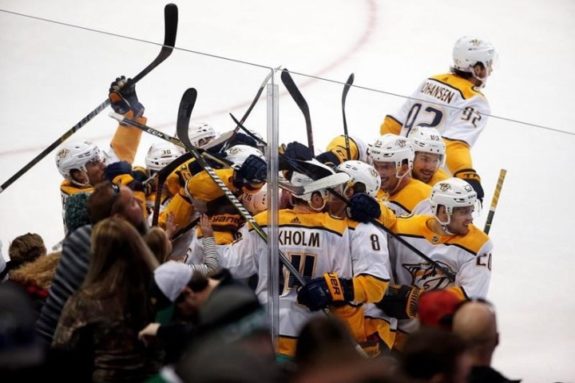
So, now it’s been established that the Predators had a quick start to the season but tailed off in recent weeks. They’ve been excellent at preventing goals and average at scoring them. They have great possession metrics but struggle on special teams. But what’s got them to this point? It starts with their blue line.
Defense Remains Most Talented Position Group
The Predators possess what is widely considered the league’s most talented defense. The rest of the team generally goes the way of the blue line as the group leads the team offensively and is pivotal at preventing goals. They were the league’s highest-scoring defense last season and have been the majority of this season as well. However, before the Christmas break began, they were overtaken by the San Jose Sharks and are tied with the Toronto Maple Leafs with 96 points.
Last season, Predators defensemen posted 206 points, an average of 2.51 points-per-game (P/G). This season, their 96 points represent an average of 2.59 P/G. They have reached that total despite the absence of P.K. Subban, who has two goals and 12 points, including four on the man advantage, in 18 games this season. In his absence, Mattias Ekholm and Roman Josi have led the position, each with at least 20 points.
However, despite the lofty offensive numbers posted by Predators defensemen, they have struggled at playing defense. Of the eight to play a game this season, all but Anthony Bitetto and Ryan Ellis have negative turnover margins with Dan Hamhuis bringing up the rear at minus-18. For defensemen like Ellis, Josi and Subban, who often have the puck on their sticks, negative turnover margins are common. However, for a defensive defenseman like Hamhuis, it’s alarming.
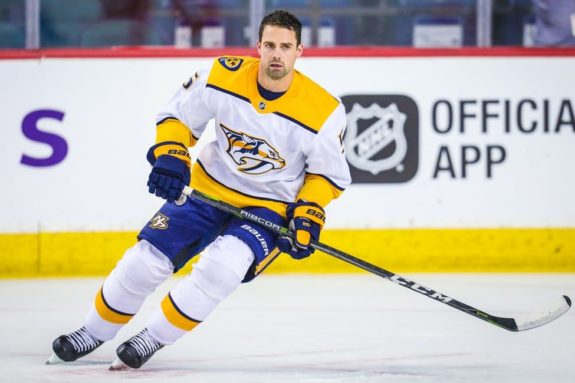
Yet despite poor individual turnover margins, the majority of their pairs have performed well and have positive five-on-five metrics with all but the Hamhuis and Yannick Weber pair having positive Fenwicks. However, the pair’s struggles are largely the result of Hamhuis, something that will further be sussed out. Three pairs: Ellis/Josi, Ekholm/Subban and Matt Irwin/Weber all have positive relative Fenwick scores, a metric that measures a pair’s effectiveness relative to the average pair.
Weber continues to be an interesting defenseman as the team has a save percentage above .950 when his three most common pairs are deployed. No other Predators defenseman can say that. Conversely, another negative for Hamhuis is that the pair with he and Ekholm is the only one with a negative goal differential. Yet when Ekholm is with Subban, his normal partner, they have a positive goal differential while starting in the offensive zone the lowest percent of team pairs.
Individually, Ellis, Hamhuis and Josi each have negative goal differentials. The biggest reason for this is that Hamhuis has looked lost on several occasions this season. Meanwhile, Josi, an offensive defenseman, has a habit of pinching in the offensive zone, a decision that leads to two-on-one opportunities for the opposition. That decision-making has impacted Ellis as he’s left to defend for two players. It has also affected the team’s goaltenders as they are put in unfair positions.
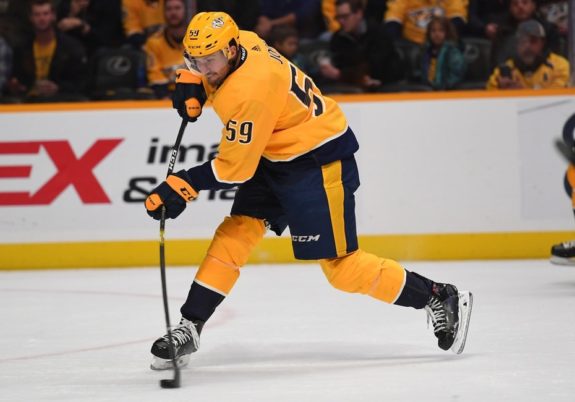
Inconsistent Goaltending
As mentioned above, the Predators are tied for seventh in the league with a .911 SV%. At five-on-five, they rank sixth with a .930 SV%. Furthermore, their .858 SV% on the penalty kill ranks 17th and their .849 SV% on the man advantage is 26th.
Pekka Rinne
Veteran netminder Pekka Rinne is the team’s starter and has been since the 2008-09 season. He won his first Vezina Trophy last season, despite it not being his best performance, and has continued that excellent play this season, for the most part. In 25 starts this season, he has a 14-8-1 record, two shutouts, a .925 SV%, a 2.15 goals-against average (GAA) and has made 11.19 goals saved above average (GSAA).
At five-on-five, and among netminders with at least 200 minutes played, Rinne’s .942 SV% ranks fifth and his .921 expected save percentage (xSV%) ranks 24th. Against medium-danger shots, his .924 SV% is 22nd and his .876 SV% versus high-danger shots is second-highest. However, those save percentages are with the caveat that he’s faced the 14th-most high-danger shots and the 19th-most medium-danger shots.
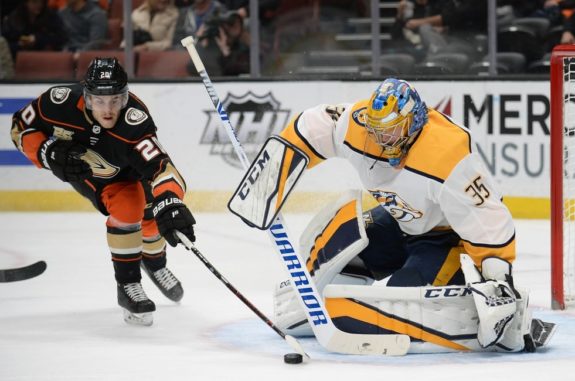
Rinne’s biggest issue this season has been inconsistency, particularly in recent games. In his 10 most recent starts, he allowed three or more goals and had a sub-.900 SV% in five of them. He only won four of those starts.
Juuse Saros
Juuse Saros is Rinne’s 23-year-old backup and the heir apparent to the Predators’ net. Entering this season, he had improved his save percentage each of the past three seasons while receiving incrementally more playing time. However, he has struggled in 2018-19 in 12 starts. He has an 8-5-1 record, one shutout, an .894 SV%, a 3.05 GAA and a minus-5.25 GSAA.
Using the same 200-minute threshold, Saros’ five-on-five numbers, including rank, are as follows: .901 SV% (54th), .915 xSV% (53rd), .899 SV% against medium-danger shots (42nd) and .772 SV% versus high-danger shots (tied for 48th). Although his numbers don’t show it, he was solid when Rinne missed time between Oct. 20 and 30 with injury.
Saros started all five of the team’s games in the span and went 3-2-0 with one shutout and a .917 SV%. He did allow at least three goals in three of the games and had a sub-.900 SV% in two. But those lackluster numbers were not entirely his fault as the Predators controlled less than 50 percent of five-on-five scoring chances in three of them and less than 50 percent of high-danger scoring chances in two.
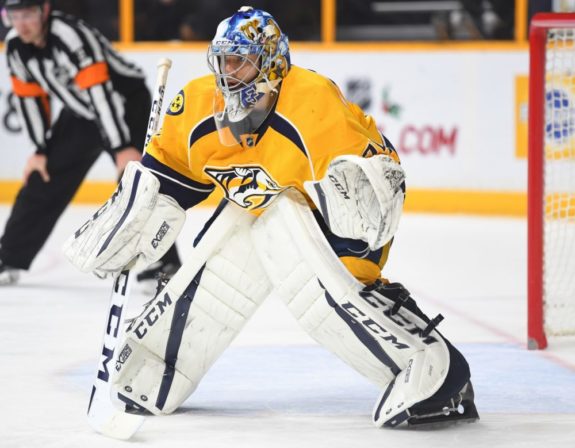
Upon Rinne’s return, Saros struggled between Nov. 10 and Dec. 8 with an .819 SV% and 1-3-0 record in five appearances. He had a save percentage below .900 in all five games and allowed at least four goals in three. However, he’s been better recently.
He relieved Rinne against the Ottawa Senators on Dec. 17 and took the loss despite getting the game to overtime. He also had a .971 SV% against the New Jersey Devils on Dec. 15. If he can continue his strong play, his ability to spell Rinne down the stretch will help the team, especially if the Predators are unable to fix their offensive woes.
Offense – Plenty of Depth, Little at the Top
The Predators aren’t a team with elite, high-end scoring. They don’t have an Alex Ovechkin, a Sidney Crosby or a Connor McDavid. But that’s an accepted reality for the team and it’s how the roster is constructed. Filip Forsberg and Ryan Johansen are top line players, but neither are going to score 50 goals or 100 points. What the team does have is offensive depth that rivals any team’s. It’s an interesting case study for building a roster.
Is it better to have a few high-end players but lack depth or to be void of an elite scorer but have scoring abilities across all four lines. The Predators are in the latter camp, which has led to regular season success, but has prevented them from winning the Stanley Cup. It’s been much of the same in 2018-19 as they once again have little in the way of high-end offense but are receiving goals up and down the lineup.
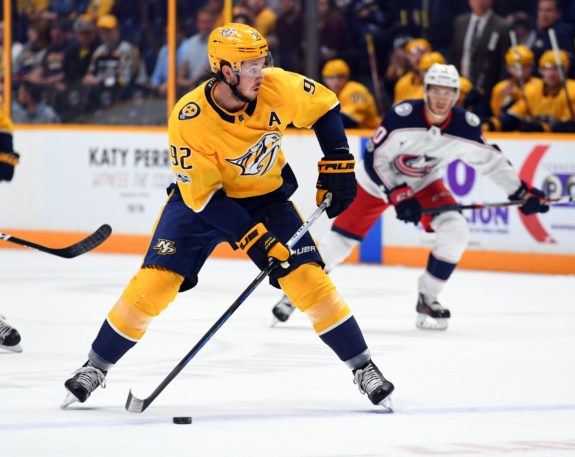
Johansen currently leads the team with 31 points in 37 games. The Predators have four players with 20-plus points, which is tied for the 17th-most 20-point players on one team. Two are defensemen, and their remaining two forwards with that many points are tied for 29th. They also have two players with at least 10 goals, tying them for 26th-most.
The Predators’ 16 games with at least four goals scored are tied for seventh-most in the league, but 10 behind the top-ranked Lightning. Their six games with five-plus goals are tied for 18th, yet they haven’t netted that many goals since Dec. 1 against the Chicago Blackhawks.
They don’t have a player in the top-40 for goals or the top-50 for points. That’s not far off last season when the Predators had one player in the top-40 of goals, but none in the top-50 for points. A large reason for their current offensive shortcomings have been injuries.
Before Viktor Arvidsson and Subban were activated off injured reserve, the team had 31 goals and 63 points on the shelf. With the addition of Forsberg, who was at a near point-per-game pace before going on injured reserve, injuries have been difficult to overcome, especially when it comes to the team’s power play success.
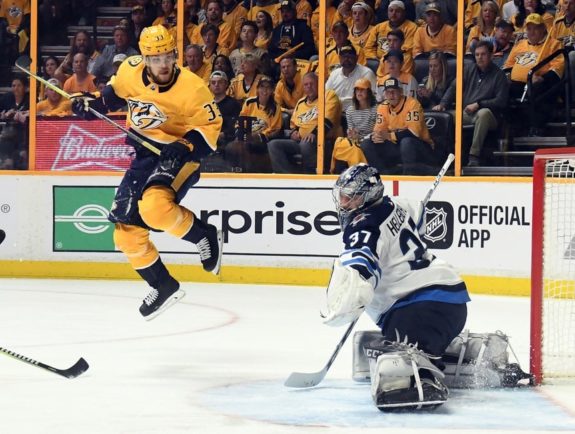
Poor Special Teams’ Play
As I previously mentioned, the Predators have converted on 14.3 percent of opportunities and tie for 26th. They have been better at killing penalties, with an 80.8 percent success rate, and rank 12th.
Power Play Woes
The team’s 14 games with at least one power play goal are tied for 24th and they have an 11-2-1 record when they convert a power play opportunity. They’ve also had four games with multiple goals on the man advantage, which tie for 16th and they have gone 2-1-1 in those games.
They haven’t scored a power play goal in their past three games and have gone two-for-24 on the man advantage in their past nine games. They were particularly bad against the Philadelphia Flyers on Dec. 20 when they failed to convert on any of their six chances. They have 10 players with a power play goal and two with multiple. Part of their struggle is injury-related, especially when you consider that three of their most talented players have missed substantial time, but it’s more than that.
I find head coach Peter Laviolette’s decision to deploy two defensemen on the man advantage to be frustrating. That is because most teams go with four forwards and some have experimented with five, so using three forwards is a decision that doesn’t equal success. The Predators’ 50.4 shots for per-60 on the power play ranks 18th, their 46.5 scoring chances for per-60 rank 19th and their 17.8 high-danger chances per-60 rank 24th.
Although they aren’t terrible when it comes to generating scoring chances or putting shots on net, they aren’t converting on these chances. So far this season, they have shot 9.9 percent on the man advantage, which ties for the 27th-highest. A cause of their low shooting percentage is that a majority of their shots originate from beyond the faceoff dots, an area that typically doesn’t translate to high levels of success.
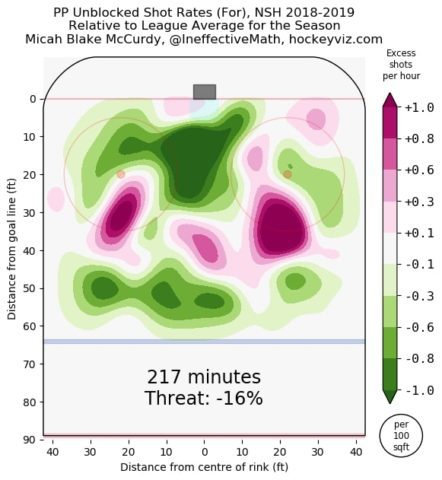
A Slightly Better Penalty Kill
The team’s 19 games with at least one power play goal allowed is tied for 18th-fewest and they have a 9-9-1 record in those games. They’ve also had four games in which they’ve allowed multiple power play goals, tied for 10th-fewest, and they have gone 0-4-0 in those games. In their nine most recent games, they allowed six power play goals and killed 24 of 30 chances for an 80 percent success rate. In their last game, against the Boston Bruins, they allowed two goals on three chances.
Their penalty killers have done well to limit chances. They rank seventh in scoring chances against per-60, seventh in high-danger chances against per-60 and 11th in shots against per-60 while shorthanded. Their .858 SV% on the penalty kill ranks 17th and their 120 times shorthanded is tied for seventh-most.
So, what’s caused their recent regression in killing penalties? Are they not pressuring the opposition enough? Are they applying too much pressure? I’m not certain. They allow relatively few shots from the slot, however, they allow an excessive amount of shots from below the faceoff dots, especially near the crease. Whether that’s poor defending down low or the opposition working the puck around to take advantage of the Predators’ pressure, it’s not a recipe that leads to success.
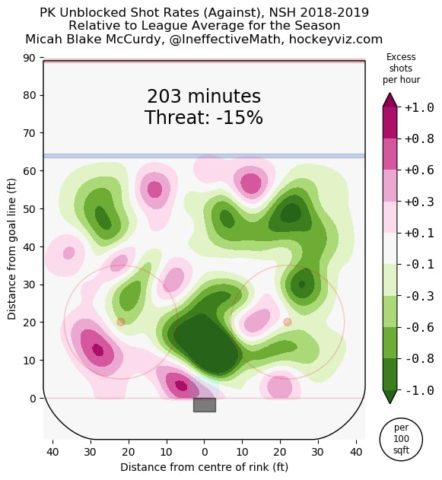
How Have Offseason Acquisitions Performed?
GM David Poile made few changes since last season concluded. He signed four players in free agency who appeared in at least one NHL game last season. They are Connor Brickley, Rocco Grimaldi, Zac Rinaldo and Hamhuis.
The Predators signed all but Hamhuis to a two-way contract and everyone except for Brickley has played in the NHL this season. Hamhuis has appeared in 26 of the team’s 37 games with four assists, Rinaldo in 20 games with one goal and Grimaldi in 18 games with one goal and one assist. Prior to being recalled, Grimaldi had four goals and 11 points in 10 AHL games.
All three were deemed low-cost signings at the time with Hamhuis having the most-lucrative contract at two years with a $1.25 million cap hit. So they were, and remain, low-risk and potentially high-reward deals. But how have the players performed this season?
Impacts
The Predators signed Hamhuis to be a veteran defensive defenseman who plays on the third pair with one of Bitetto, Irwin or Weber. Some may not remember this, but he was drafted by the Predators 11th overall in the 2001 Entry Draft and he played his first six seasons with them. With how much Laviolette leans on his top two pairs, Hamhuis was likely only going to play around 15 minutes per game in an insulated role and be a presence on the penalty kill.
However, Subban’s injury changed that as Hamhuis has played on the second pair with Ekholm, a move that has not yielded good results. For one, it has messed up the team’s left/right-shot balance as both players are left shots. Them playing together has also resulted in poor metrics as Hamhuis is dragging Ekholm down. Hamhuis has been on the ice for 17.4 percent of opponents’ power play goals, so he has struggled on the penalty kill as well.
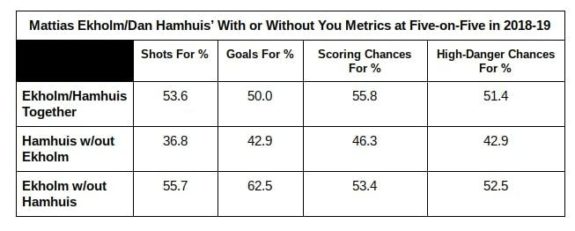
If Hamhuis has underperformed, Grimaldi has been the opposite. He was in the AHL until injuries piled up at the NHL level. Since his most recent recall, he’s played in a fourth line checking role with Frédérick Gaudreau and Miikka Salomäki and is likely to surpass his career-high of 20 games played in a season.
He has been tenacious on the forecheck, has a positive turnover margin and often maintains the team’s momentum from when more offensively-gifted lines were deployed. The question will be whether or not he remains in the NHL after injured players return to the lineup.
As far as Rinaldo is concerned, I don’t understand why the Predators signed him. He is a gritty player who has served an enforcer role in the past. The Predators aren’t a team that typically gets into scuffles with the opposition, so it wouldn’t make sense for them to sign him for that purpose. He also doesn’t provide much offense as he has one goal on the season and has never scored more than five goals or nine points in a season.
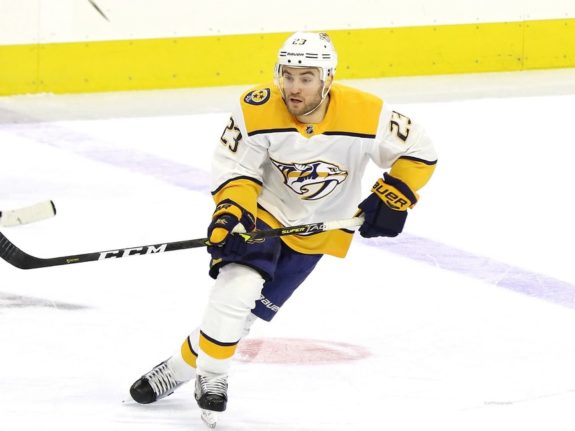
What Should They Do the Rest of the Season?
Although the Predators have scuffled of late, they are still in a strong position as the Christmas break concludes. The return of Arvidsson and Subban will have positive impacts on the team. Add to that Forsberg’s looming return and the team should get back on track. However, I have doubts that those returns will be enough to address all of the team’s problems.
While all three players receive substantial time on the power play, the team still needs to fix their setup on the man advantage. Subban’s shot from the point is dynamic from the right side and Arvidsson and Forsberg are talented forwards, but as long as the team uses two defensemen, the power play will likely struggle.
Another way to fix their power play woes, and improve their struggling offense, would be to add a top-six forward, but it won’t be cheap. A few weeks ago, I wrote an article that argued trading Josi for such a player. With how the team has performed since I wrote that article, I feel stronger about using him as a trade chip.
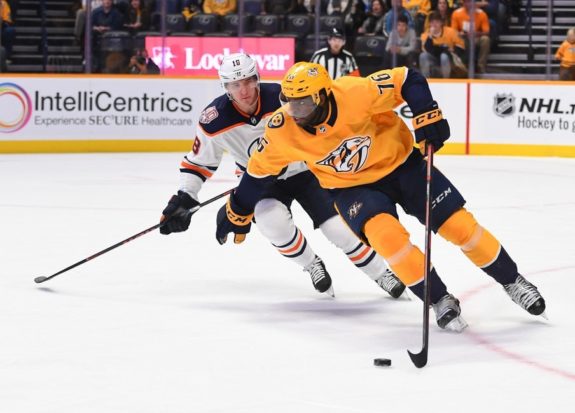
For one, he hasn’t played that well despite his lofty offensive numbers. He has regularly left Ellis out to dry and the result has been high-danger scoring chances for the opposition. The Predators have enough defensive depth to overcome the loss of Josi and his value would bring in the player the team needs. It’s my belief that until Poile adds a top-six forward, the Predators won’t be a true Stanley Cup contender, because as they are currently constructed, they won’t get past the Lightning or Winnipeg Jets come playoff time.
Let me know in the comments below how you think the Predators have done so far this season and what they need to do the remainder of the season.
*All stats came from Hockey-Reference, Elite Prospects, Natural Stat Trick and Corsica